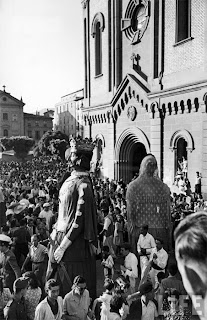Let's start with some useful classroom vocabulary. Practice it!
Welcome to my blog. Here you can practise and improve your English in a different way. You will find interesting and useful links: culture and history, grammar, phonetic, FCE, vocabulary tasks, texts, videos, songs, English organization…
jueves, 15 de septiembre de 2016
STARTING 4º ESO
Let's do some English activities:
Go to: Menu: 4ºESO > INTERMEDIATE > The _ED SUFFIX
- 2nd: Now watch this short video and answer the questions about it.
- 3rd: You need to "revise" your Irregular verbs.
Have you finished?
- Then you can "visit" London after all you've learnt about the city.
jueves, 7 de julio de 2016
SANFERMIN GIANTS AND BIGHEADS
HISTORY
According to a rather obscure tradition, during the procession of San Fermín in 1276, three Giants, called, Peru Suziales, Mari Suziales, his wife, and one called Jusef Lukurari (" The Usurer") - a personification of the popular repulsion against the Jews at that time, - were paraded dancing through the streets.
But the first authentic references to The Giants in San Fermin date from the beginning of the XVII century; in 1607 one Joanes de Azcona is named as being responsible for bringing out the assemblage of Giants along with a minstrel who was responsible for providing the accompanying music. In 1620 it is recorded that a carpenter, Joan de Torrobas, was paid 88 "reales" to mend four Giants.
It was the custom around that time to parade Giants in the evenings, after the bullfights, which were adorned with crackers and fireworks,(not unlike the present-day mechanical contrivance of the "Torch Bull" borne by a human) and which were frolicked around the square, before eventually ending up on the bonfire.
This practice of having Giants in the celebrations continued through the greater part of the XVIII century, until in 1780, The King, Carlos III, banned " the use of dancing Giants for leading any religious processions inside or outside all churches within this Kingdom" (by Royal Decree of tenth of July, 1780) which put a stop to the use of any Giants during the San Fermin celebrations. The Giants which had belonged to the Town Hall disappeared without any further trace while the Giants which belonged to the Cathedral were stored away and forgotten about, until 1813 when they were discovered by a carpenter who revived the old tradition by bringing them out once again into the streets. The response was so enthusiastic that The Town Hall gradually built up their own collection of Giants, along with accompanying figures such as the Zaldikos, Kilikis, and Cabezudos.
The Giants that are presently in use date from 1860 and were made by one Tadeo Amorena, a local painter from Pamplona. He presented a scheme to the Town Hall in March of that year to built four new Giants which would represent the "four corners of the world" and which would be more durable and yet lighter than the old ones. A local poet- one Ignacio Baleztena- couldn't help but write some caustic lines on the fact that :
"It seems poor Tadeo had never heard tell of The Oceanic Continent".
The present cabezudos in use were built in 1890 by one Félix Flores. Some of kilikis and zaldikos are from the last century while the rest date from this century.
miércoles, 6 de julio de 2016
SAN FERMIN 6th - 14th JULY
Sanfermin
 The festival of Sanfermín (or Sanfermines) in the city of Pamplona (Navarre, Spain), is a deeply rooted celebration held annually from 12:00, 6 July, when the opening of the fiesta is marked by setting off the pyrotechnic txupinazo, to midnight 14 July, with the singing of the Pobre de Mí.
The festival of Sanfermín (or Sanfermines) in the city of Pamplona (Navarre, Spain), is a deeply rooted celebration held annually from 12:00, 6 July, when the opening of the fiesta is marked by setting off the pyrotechnic txupinazo, to midnight 14 July, with the singing of the Pobre de Mí.
 Sanfermin is internationally known for the event of the running of the bulls, where the bulls are let loose through some of the streets of the old part of the city. The runnings of the bulls take place from the 7th of July to the 14th of July inclusive at 8.00 am in the morning. At midday on the 6th of July the fiestas open with the txupinazo rocket. That day there is no running of the bulls but there sure is a lot of partying. It was thanks to the writing of American writer Ernest Hemingway that San Fermin developed the notoriety of today. The publication of his novel "The Sun Also Rises" in 1926 told the world about the Pamplona bull running festival which attracted people from all over the world to this annual festival.
Sanfermin is internationally known for the event of the running of the bulls, where the bulls are let loose through some of the streets of the old part of the city. The runnings of the bulls take place from the 7th of July to the 14th of July inclusive at 8.00 am in the morning. At midday on the 6th of July the fiestas open with the txupinazo rocket. That day there is no running of the bulls but there sure is a lot of partying. It was thanks to the writing of American writer Ernest Hemingway that San Fermin developed the notoriety of today. The publication of his novel "The Sun Also Rises" in 1926 told the world about the Pamplona bull running festival which attracted people from all over the world to this annual festival.
Riau Riau
Pobre de mí
At midnight on the 14 th July the fiesta formally closes with the ceremony called the "Pobre de Mí."

 The festival of Sanfermín (or Sanfermines) in the city of Pamplona (Navarre, Spain), is a deeply rooted celebration held annually from 12:00, 6 July, when the opening of the fiesta is marked by setting off the pyrotechnic txupinazo, to midnight 14 July, with the singing of the Pobre de Mí.
The festival of Sanfermín (or Sanfermines) in the city of Pamplona (Navarre, Spain), is a deeply rooted celebration held annually from 12:00, 6 July, when the opening of the fiesta is marked by setting off the pyrotechnic txupinazo, to midnight 14 July, with the singing of the Pobre de Mí.  Sanfermin is internationally known for the event of the running of the bulls, where the bulls are let loose through some of the streets of the old part of the city. The runnings of the bulls take place from the 7th of July to the 14th of July inclusive at 8.00 am in the morning. At midday on the 6th of July the fiestas open with the txupinazo rocket. That day there is no running of the bulls but there sure is a lot of partying. It was thanks to the writing of American writer Ernest Hemingway that San Fermin developed the notoriety of today. The publication of his novel "The Sun Also Rises" in 1926 told the world about the Pamplona bull running festival which attracted people from all over the world to this annual festival.
Sanfermin is internationally known for the event of the running of the bulls, where the bulls are let loose through some of the streets of the old part of the city. The runnings of the bulls take place from the 7th of July to the 14th of July inclusive at 8.00 am in the morning. At midday on the 6th of July the fiestas open with the txupinazo rocket. That day there is no running of the bulls but there sure is a lot of partying. It was thanks to the writing of American writer Ernest Hemingway that San Fermin developed the notoriety of today. The publication of his novel "The Sun Also Rises" in 1926 told the world about the Pamplona bull running festival which attracted people from all over the world to this annual festival.
The fiestas are celebrated in honor of Saint Fermin, patron of Navarra, and both the religious elements and the wild partying elements live out the fiestas in good harmony.
The Txupinazo VIDEO 2014
The explosion of the fireworks rocket at midday on the 6th of July is the signal for the start of nine days of non-stop partying. This moment is marked by a rocket - the "Txupinazo" - which is set off to announce the start of the Fiesta.Riau Riau
On the 6th of July, at 4.30 in the afternoon, Sanfermin tradition dictates that everyone should gather for the riau-riau. Nowadays, the motivation is rather different to the original reason.
The municipal band, "La Pamplonesa" played a set piece of music "el Valls de Astráin" and the people danced, sang, drank and blocked the route for as long as possible.
Procession
The 7th of July, at 10.00 am on the day, the procession of Saint Fermin leaves from the church of San Lorenzo. The route is jam-packed with crowds who want to see the image of the saint and the entourage that accompany the figure of the saint.
Bull Running
All the information, photos and videos on the most emblematic event in Sanfermin
The corrida
The corrida or bullfight during San Fermin is very different to bullfights in any other big bullring in Spain or anywhere else. For the simple reason that it is something more than just a bullfight.
Pobre de mí
At midnight on the 14 th July the fiesta formally closes with the ceremony called the "Pobre de Mí."

martes, 5 de julio de 2016
lunes, 4 de julio de 2016
INDEPENDENCE DAY - 4th JULY
 Independence Day in the United States is also known as the Fourth of July. It is a national holiday that commemorates the Declaration of Independence on July 4, 1776. This was the day the USA was born and became independent from Great Britain. The terms “Independence Day” and the “Fourth of July” are a well-known part of the USA’s cultural language. People celebrate with national pride. There are fireworks, parades, sporting events and lots more. It is one of the biggest days on America’s holiday calendar. Politicians make speeches celebrating America’s history and traditions. In particular, attention turns to Thomas Jefferson’s speech that declared the United States of America as an independent nation.
Independence Day in the United States is also known as the Fourth of July. It is a national holiday that commemorates the Declaration of Independence on July 4, 1776. This was the day the USA was born and became independent from Great Britain. The terms “Independence Day” and the “Fourth of July” are a well-known part of the USA’s cultural language. People celebrate with national pride. There are fireworks, parades, sporting events and lots more. It is one of the biggest days on America’s holiday calendar. Politicians make speeches celebrating America’s history and traditions. In particular, attention turns to Thomas Jefferson’s speech that declared the United States of America as an independent nation.
Independence Day is a red, white and blue affair. The whole of the country displays American flags and banners. There are many festivals that enact famous events from America’s history. It is also a day when the nation gets outdoors. Picnics and barbecues with family and friends are the most popular ways to celebrate. In the evening, there are thousands of fireworks displays across the country. One of the most popular is the Macy’s department store show on New York’s East River. This is televised nationwide by the NBC TV channel. Also in New York, you can witness the Hot Dog Eating Contest on Coney Island. Indeed, American food is of course a big part of the day and millions of hot dogs, burgers and pizzas are eaten.

domingo, 26 de junio de 2016
jueves, 23 de junio de 2016
SAINT JOHN THE BAPTIST DAY AND EVE
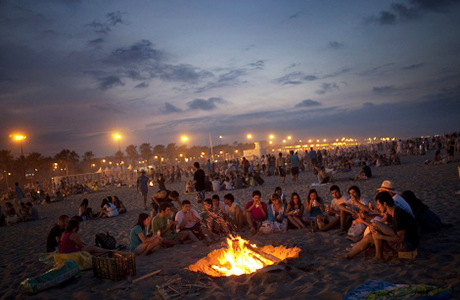 The evening of 23 June, St John's Eve, is the eve of celebration before the Feast Day of St John the Baptist. The Gospel of Luke (Luke 1:36, 56–57) states that John was born about six months before Jesus, therefore the feast of John the Baptist was fixed on 24 June six months before Christmas. This feast day is one of the very few saints' days to mark the supposed anniversary of the birth, rather than the death, of the saint commemorated.
The evening of 23 June, St John's Eve, is the eve of celebration before the Feast Day of St John the Baptist. The Gospel of Luke (Luke 1:36, 56–57) states that John was born about six months before Jesus, therefore the feast of John the Baptist was fixed on 24 June six months before Christmas. This feast day is one of the very few saints' days to mark the supposed anniversary of the birth, rather than the death, of the saint commemorated.
The Feast of St John coincides with the June solstice also referred to as Midsummer. The Christian holy day is fixed at 24 June but in some countries, festivities are celebrated the night before on St John's Eve.
Saint John the Baptist Day is celebrated in many villages and towns. Many events take place on the evening of June 23. People celebrate Saint John the Baptist Day by:
- Lighting bonfires, jumping over small fires (correfocs) and setting off fireworks.
- Writing wishes or sins on a piece of paper and burning the paper.
- Diving or bathing in dew, a stream, a river or the sea.
- Staying awake all night near a small fire.
- Watching the sun rise on the morning of June 24.
- Collecting and cooking with the herbs thyme, rosemary and verbena.
MIDSUMMER'S EVE
 Midsummer Eve is fast approaching. Midsummer may simply refer to the period of time centered upon the summer solstice, but more often refers to specific European celebrations that accompany the actual solstice, or that take place around the 24th of June and the preceding evening. The exact dates vary between cultures.
Midsummer Eve is fast approaching. Midsummer may simply refer to the period of time centered upon the summer solstice, but more often refers to specific European celebrations that accompany the actual solstice, or that take place around the 24th of June and the preceding evening. The exact dates vary between cultures.
European midsummer-related holidays, traditions, and celebrations are pre-Christian in origin.
When is Midsummer's Day?
Midsummer's Day, the middle of summer, falls on on 24 June, after the longest day (Summer Solstice). Before the change of calendars, Midsummer's day fell on 5 July.
Why are Midsummer's Day and the Summer Solstice not on the same day?
The longest day in the northern hemisphere is today either the 20th or 21st of June, whilst Midsummer's Day in Europe is traditionally on 24 June.This discrepancy is said to have been caused by the variants of the Julian Calendar and the Tropical Year further confused by the Gregorian Calendar.
What used to happen on Midsummer's Eve?
Midsummer's Eve is a time associated with witches, magic, fairies and dancing.On the eve of Midsummer's Day, many bonfires were lit all over the country. This was in praise of the sun, for the days were getting shorter and the sun appeared to be getting weaker, so people would light fires to try and strengthen the sun.
Midsummer's Eve today
Midsummer's Eve today
Practice of this ancient ritual, which also includes a Summer Solstice Circle Dance, is now mainly confined to Cornwall, the West Country, and London's Hampstead Heath.
Midsummer's Superstitions
Roses are of special importance on Midsummer's Eve. It is said that any rose picked on Midsummer's Eve, or Midsummer's Day will keep fresh until Christmas.
At midnight on Midsummer's Eve, young girls should scatter rose petals before them and say:
Rose leaves, rose leaves,
Rose leaves I strew.
He that will love me
He that will love me
Come after me now.
Then the next day, Midsummer's Day, their true love will visit them.
MIDSUMMER'S EVE IN SPAIN
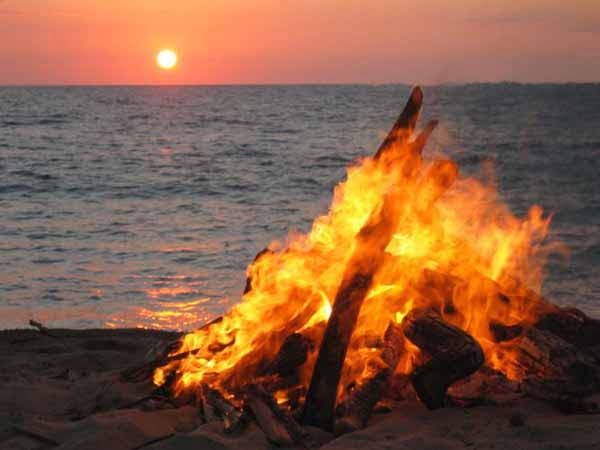 The traditional midsummer party in Spain is the celebration in honour of San Juan (St. John the Baptist) and takes place in the evening of June 23. It is common in many areas of the country. Parties are organised usually at beaches, where bonfires are lit and a set of firework displays usually take place. On the Mediterranean coast, especially in Catalonia and València, special meals like Coca de Sant Joan are also served on this occasion. In Alicante, since 1928, the bonfires of Saint John were developed into elaborate constructions inspired by the Fallas of Valencia.
The traditional midsummer party in Spain is the celebration in honour of San Juan (St. John the Baptist) and takes place in the evening of June 23. It is common in many areas of the country. Parties are organised usually at beaches, where bonfires are lit and a set of firework displays usually take place. On the Mediterranean coast, especially in Catalonia and València, special meals like Coca de Sant Joan are also served on this occasion. In Alicante, since 1928, the bonfires of Saint John were developed into elaborate constructions inspired by the Fallas of Valencia.
Midsummer tradition is also especially strong in northern areas of the country, such as Galicia, where one can easily identify the rituals that reveal the pagan beliefs widespread throughout Europe in Neolithic times. These beliefs pivot on three basic ideas: the importance of medicinal plants, especially in relation to health, youth and beauty; the protective character of fire to ward men off evil spirits and witches and, finally, the purifying, miraculous effects of water.
lunes, 20 de junio de 2016
FIRST DAY OF SUMMER 2016: THE SUMMER SOLSTICE
This June, 2016, the solstice and full Moon coincide—a rare event, indeed.
WHEN IS THE SUMMER SOLSTICE?
In 2016, the solstice falls on June 20 at 6:34 p.m. EDT. This is the “summer” solstice in the Northern Hemisphere.
The timing of the solstice depends on when the Sun reaches its northernmost point of the equator.
WHAT IS THE SUMMER SOLSTICE?
The word solstice is from the Latin solstitium, from sol (sun) and stitium (to stop), reflecting the fact that the Sun appears to stop at this time (and again at the winter solstice).
In temperate regions, we notice that the Sun is higher in the sky throughout the day, and its rays strike Earth at a more direct angle, causing the efficient warming we call summer.
This summer solstice is the day with the most hours of sunlight during the whole year. See our handy sunrise and sunset calculator for how many hours of sunlight you get in your location.
At the winter solstice, just the opposite occurs: The Sun is at its southernmost point and is low in the sky. Its rays hit the Northern Hemisphere at an oblique angle, creating the feeble winter sunlight.
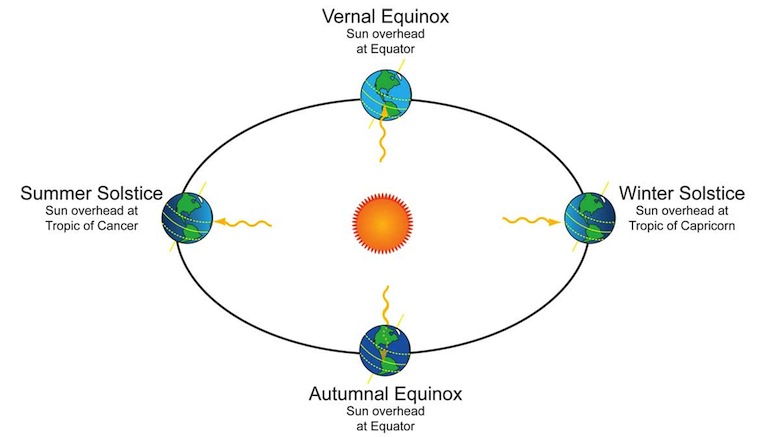
jueves, 16 de junio de 2016
HAPPY BLOOMSDAY

June the 16th is Bloomsday when Ireland celebrates the life of James Joyce. Bloomsday is a commemoration observed annually in Dublin and elsewhere in the world to celebrate the life of Irish writer James Joyce and recall the events in his novel Ulysses, all of which took place on the same day in Dublin in 1904. Joyce chose the date because his first outing with his wife-to-be, Nora Barnacle happened on that day. The name derives from Leopold Bloom, the protagonist of Ulysses.
James Joyce lived for a time in Martello Tower situated beside the Forty Foot bathing place at Sandycove, a small village 7 miles south of Dublin. The opening scene of Joyce's Ulysses is set in this tower, which now hosts a small Joycean museum. Its people celebrate it with readings, music, songs, walking tours, and of course eating and drinking.
miércoles, 15 de junio de 2016
martes, 14 de junio de 2016
ROYAL ASCOT : 14th - 18tht JUNE_2016
 The centrepiece of Ascot’s year, Royal Ascot is one of Europe's most famous race meetings, and dates back to 1711 when it was founded by Queen Anne. Every year Royal Ascot is attended by HM Elizabeth II and various members of the British Royal Family such as The Prince of Wales, arriving each day in a horse-drawn carriage with the Royal procession taking place at the start of each race day and the raising of the Queens royal Standard. It is a major event in the British social calendar, and press coverage of the attendees and what they are wearing often exceeds coverage of the actual racing. There are 3 enclosures attended by guests on Royal Ascot week.
The centrepiece of Ascot’s year, Royal Ascot is one of Europe's most famous race meetings, and dates back to 1711 when it was founded by Queen Anne. Every year Royal Ascot is attended by HM Elizabeth II and various members of the British Royal Family such as The Prince of Wales, arriving each day in a horse-drawn carriage with the Royal procession taking place at the start of each race day and the raising of the Queens royal Standard. It is a major event in the British social calendar, and press coverage of the attendees and what they are wearing often exceeds coverage of the actual racing. There are 3 enclosures attended by guests on Royal Ascot week.
The Dress is strictly enforced, for Ladies only a day dress with a hat or fascinator is acceptable with rules applying to the length of the dress and ladies must not show bare midriffs or shoulders. For gentlemen a black or grey morning dress with top hat.
Over 300,000 people make the annual visit to Berkshire during Royal Ascot week, making this Europe’s best-attended race meeting. This leads to a split among racing fans, some of whom are glad to see racing in the spotlight, and getting more attention, while others do not like the meeting despite the quality of racing.
There are 16 Group races on offer, with at least one Group One event on each of the five days. The Ascot Gold Cup is on Ladies' Day on the Thursday. There is over £3,000,000 of prize money on offer.
WEB INFORMATION
WEB INFORMATION
FLAG DAY 14th JUNE - USA
 On 14 June 1777, the Continental Congress approved the design of the Stars and Stripes as the official flag of the U.S. The first Flag Act was passed on this day stating that "the flag of the United States be made of thirteen stripes, alternate red and white; that the union be thirteen stars, white in a blue field, representing a new Constellation."
On 14 June 1777, the Continental Congress approved the design of the Stars and Stripes as the official flag of the U.S. The first Flag Act was passed on this day stating that "the flag of the United States be made of thirteen stripes, alternate red and white; that the union be thirteen stars, white in a blue field, representing a new Constellation."
Between 1777 and 1960, US Congress passed several acts that changed the shape, design and arrangement of the flag and allowed for additional stars and stripes to be added to reflect the admission of each new state.
Today the flag consists of thirteen horizontal stripes, seven red alternating with 6 white. The stripes represent the original 13 colonies, the stars represent the 50 states of the Union.
What do the colours red, white and blue represent?
The colours of the flag are symbolic as well: Red symbolizes Hardiness and Valour, White symbolizes Purity and Innocence and Blue represents Vigilance, Perseverance and Justice.
What do the fifty stars represent today?
Today the number of stars on the US flag has grown to 50 from the original 13. Since 1818, the stars have represented every state in the Union.
What do the thirteen stripes represent?
They represented the thirteen American colonies which rallied around the new flag in their fight against the British for self-governance.
The thirteen colonies included Connecticut, Delaware, Georgia, Maryland, Massachusetts, New Hampshire, New Jersey, New York, North Carolina, South Carolina, Pennsylvania, Rhode Island and Virginia.
sábado, 11 de junio de 2016
TROPPING THE COLOUR 2016
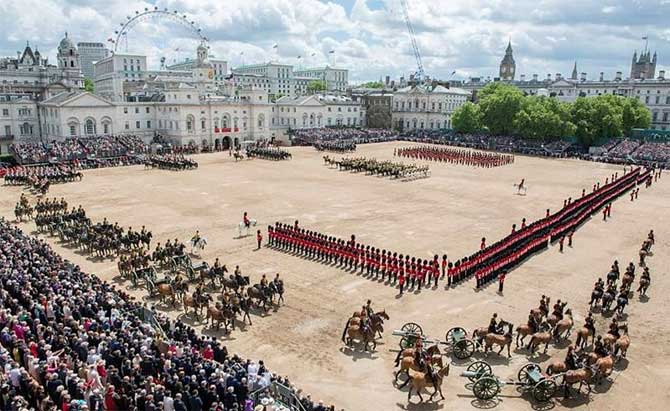
Trooping the Colour / Queen's Birthday Parade
In June each year the highlight of the ceremonial calendar, Trooping the Colour, also known as 'The Queen's Birthday Parade' takes place on Horse Guards Parade in London.
Trooping the Colour 2016
The dates for Trooping the Colour and the two reviews in 2016 are:
Major General’s Review - Saturday 28th May.
The Colonel’s Review - Saturday 4th June
Queen’s Birthday Parade - Saturday 11th June
The Coldstream Guards Colour will be Trooped at the Queen’s Birthday Parade this year.
Although The Queen was born on 21 April, it has long been the tradition to celebrate the Sovereign's Birthday in the summer.
More than 1,400 officers and men and approximately 400 musicians from the Massed Bands of the Household Division take part in Trooping the Colour and the Reviews which are full dress rehearsals for the Queen's Birthday Parade.
The Ceremony
The Queen travels down The Mall from Buckingham Palace, by carriage, with a Sovereign's escort from the Household Cavalry Mounted Regiment.
As the clock on Horse Guards chimes eleven Her Majesty The Queen arrives to take the Royal Salute from the officers and men of the Household Division on parade.
After the salute The Queen rides up and down the ranks, in her carriage, inspecting the troops on parade.
After the massed bands have performed a musical 'troop', the Regimental Colour being trooped is escorted down the ranks of Guards.
The Foot Guards and the Household Cavalry then march past Her Majesty, and The King's Troop, Royal Horse Artillery, rank past with their Guns.
The Queen, in a carriage, rides back to Buckingham Palace at the head of her Guards, before taking the salute at the Palace from a dais in front of the palace railings as the troops march past on the way to their barracks.
Her Majesty The Queen joins other members of the Royal Family on the balcony of Buckingham Palace to watch a fly-past by the Royal Air Force at 1 'o' clock.
About The Colour
Trooping the Colour originated from traditional preparations for battle when a Regiment's Colour was carried, or "trooped", down the ranks so that they could be seen and recognised by the soldiers who would use them as a rallying point in the confusion of battle.
miércoles, 18 de mayo de 2016
INTERNATIONAL MUSEUM DAY_ 18th MAY 2016
Every year since 1977 International Museum Day is organised worldwide around May 18.
This day is an occasion to raise awareness on how important museums are in the development of society.
Each year’s International Museum Day theme is proposed by ICOM’s network and aims to promote museum issues within society.
In 2016, the event will celebrate the theme:Museums and Cultural Landscapes.
The theme Museums and Cultural Landscapes makes museums responsible for their landscapes, asking them to contribute knowledge and expertise and take an active role in their management and upkeep. The primary mission of museums is to oversee heritage, whether it be inside or outside their walls. Their natural vocation is to expand their mission and implement their own activities in the open field of cultural landscape and heritage that surrounds them and for which they can assume varying degrees of responsibility.
Download the Poster
Highlighting the link between museums and cultural heritage enhances the idea of museums as territorial centres involved in actively protecting the cultural landscape.
viernes, 13 de mayo de 2016
REPORTED SPEECH - ONLINE EXERCISES
Reported Speech exercises
Reported Speech 2 exercises
Reported Speech 3 exercises
Reported1
Reportedspeech/statements
Change to Reported Speech
Reported Speech/commands
Reported Speech Questions
Reported Speech sentences
Reported Speech sentences 2
Reported Speech sentences 3
She said.... He said....
Reported Speech Quiz

REPORTED SPEECH
REPORTED SPEECH EXERCISES
Here you have several exercises to practise Reported Speech:
REPORTED SPEECH 2
REPORTED SPEECH LISTENING
SAY, TELL, ASK

REPORTED SPEECH LISTENING

Suscribirse a:
Entradas (Atom)







